To Care or Not to Care? Which Factors Influence the Distribution of Early-Flowering Geophytes at the Vienna Central Cemetery (Austria)
Abstract
1. Introduction
2. Materials and Methods
2.1. Study Area
2.2. Cemetery Types
2.3. Sampling Design
2.3.1. Site-Specific Variables
2.3.2. Data Collection
2.4. Analysis
3. Results
3.1. Early-Flowering Geophyte Species Distribution and Abundance
3.2. Cemetery Types
3.3. Intensity of Care
3.4. Type of Use
3.5. Distance to the Next Main Path
3.6. Multivariate Analysis
4. Discussion
5. Conclusions
Author Contributions
Funding
Institutional Review Board Statement
Informed Consent Statement
Data Availability Statement
Acknowledgments
Conflicts of Interest
Appendix A
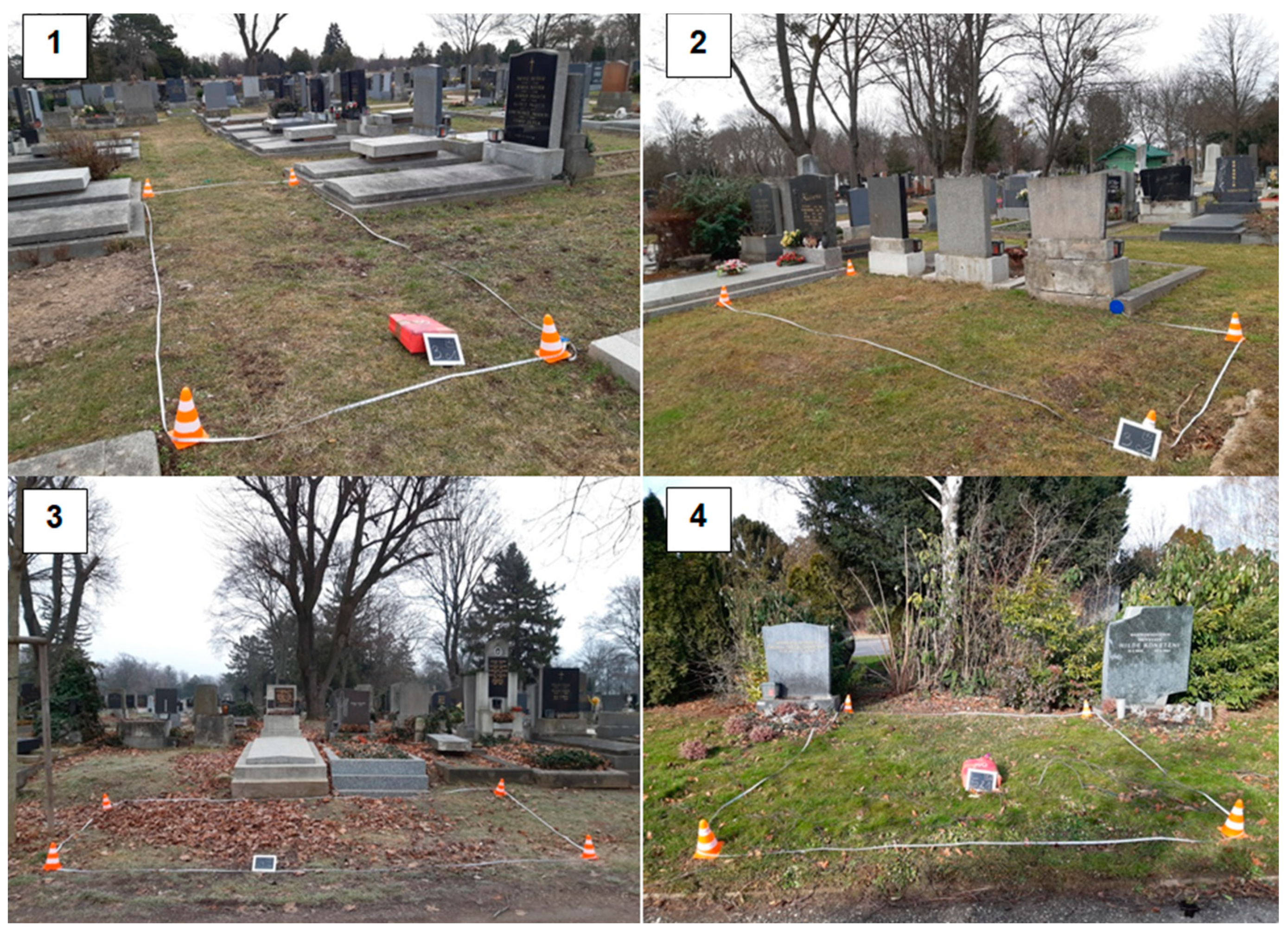
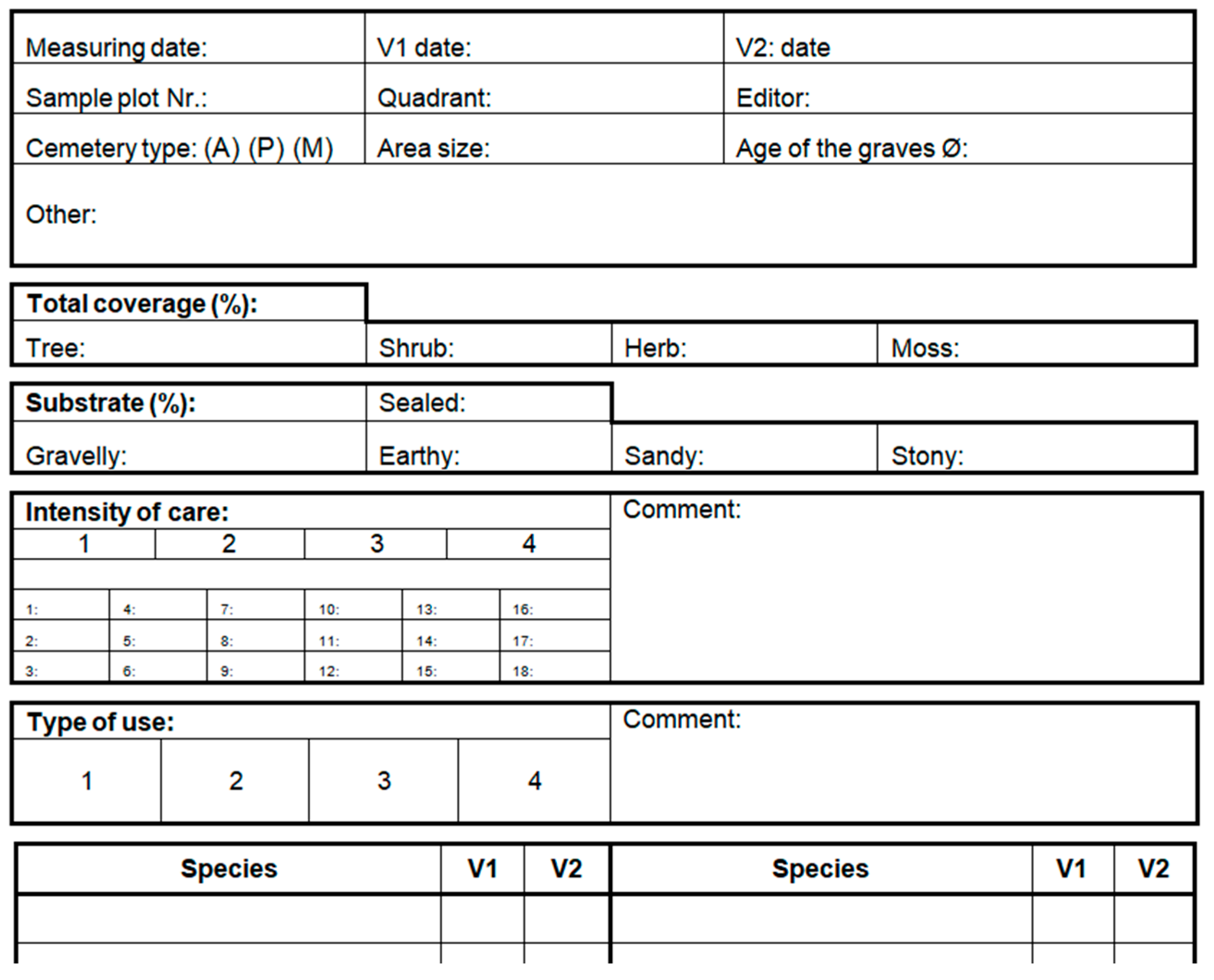

| Attribute | Category | Number of Geophyte Species |
|---|---|---|
| Cemetery type | A | 6 |
| P | 3 | |
| M | 7 | |
| Intensity of care | 1 | 9 |
| 2 | 5 | |
| 3 | 3 | |
| 4 | 3 | |
| Type of use | 1 | 2 |
| 2 | 6 | |
| 3 | 5 | |
| 4 | 7 | |
| Distance to the next main path | 0–5 m | 7 |
| 5–15 m | 8 | |
| 15–105 m | 5 |
References
- Nowińska, R.; Czarna, A.; Kozłowska, M. Cemetery types and the biodiversity of vascular plants–A case study from south-eastern Poland. Urban For. Urban Green. 2020, 49, 126599. [Google Scholar] [CrossRef]
- Yılmaz, H.; Kuşak, B.; Akkemik, Ü. The role of Aşiyan Cemetery (İstanbul) as a green urban space from an ecological perspective and its importance in urban plant diversity. Urban For. Urban Green. 2018, 33, 92–98. [Google Scholar] [CrossRef]
- Buchholz, S.; Blick, T.; Hannig, K.; Kowarik, I.; Lemke, A.; Otte, V.; Scharon, J.; Schönhofer, A.; Teige, T.; von der Lippe, M.; et al. Biological richness of a large urban cemetery in Berlin. Results of a multi-taxon approach. Biodivers. Data J. 2016, 4, e7057. [Google Scholar] [CrossRef] [PubMed]
- Barrett, G.W.; Barrett, T.L. Cemeteries as repositories of natural and cultural diversity. Conserv. Biol. 2001, 15, 1820–1824. [Google Scholar] [CrossRef]
- Al-Akl, N.M.; Nasser Karaan, E.; Al-Zein, M.S.; Assaad, S. The landscape of urban cemeteries in Beirut: Perceptions and preferences. Urban For. Urban Green. 2018, 33, 66–74. [Google Scholar] [CrossRef]
- Schmidt, A. Friedhöfe und Naturschutz-Bedeutung der Friedhöfe für die Tier- und Pflanzenwelt; Laufender Seminarbeitrag; Bayerische Akademie für Naturschutz und Landschaftspflege ANL: Laufen an der Salzach, Germany, 1994; pp. 53–59. [Google Scholar]
- Venne, M.; Güß, K.; Friedrich, J.; Venne, A. Öffentliche Leistungen und Funktionen aktiver Friedhöfe (Forschungsbericht No. Az.29884), DBU-Forschungsprojekt; Deutsches Bundesstiftung Umwelt: Osnabrück, Germany, 2016. [Google Scholar]
- Laske, D. Friedhöfe-ökologische Nischen im besiedelten Raum. Naturwissenschaften 1994, 81, 218–223. [Google Scholar]
- Löki, V.; Schmotzer, A.; Takács, A.; Süveges, K.; Lovas-Kiss, Á.; Lukács, B.A.; Tökölyi, J.; Molnár, V.A. The protected flora of long-established cemeteries in Hungary: Using historical maps in biodiversity conservation. Ecol. Evol. 2020, 10, 7497–7508. [Google Scholar] [CrossRef] [PubMed]
- Buch, C.; Keil, P. Friedhöfe tragen zur urbanen Biodiversität bei-Ergebnisse einer floristischen Kartierung in Mülheim an der Ruhr. Nat. NRW 2020, 2, 22–27. [Google Scholar]
- Löki, V.; Molnár, V.A.; Süveges, K.; Heimeier, H.; Takács, A.; Nagy, T.; Fekete, R.; Lovas-Kiss, Á.; Kreutz, K.C.A.J.; Sramkó, G.; et al. Predictors of conservation value of Turkish cemeteries: A case study using orchids. Landsc. Urban Plan. 2019, 186, 36–44. [Google Scholar] [CrossRef]
- Kowarik, I.; Buchholz, S.; von der Lippe, M.; Seitz, B. Biodiversity functions of urban cemeteries: Evidence from one of the largest Jewish cemeteries in Europe. Urban For. Urban Green. 2016, 19, 68–78. [Google Scholar] [CrossRef]
- Friedhöfe Wien GmbH. Bestattungsanlagenordnung (BAO)-GZ:77/18. 2018. Available online: https://www.friedhoefewien.at/media/files/2018/bestattungsanlagenordnung_stand%20mai%202018_243547.pdf (accessed on 21 December 2020).
- Quinton, J.M.; Duinker, P.N. Beyond burial: Researching and managing cemeteries as urban green spaces, with examples from Canada. Environ. Rev. 2019, 27, 252–262. [Google Scholar] [CrossRef]
- Skår, M.; Nordh, H.; Swensen, G. Green urban cemeteries: More than just parks. J. Urban. Int. Res. Placemaking Urban Sustain. 2018, 11, 362–382. [Google Scholar] [CrossRef]
- Evensen, K.H.; Nordh, H.; Skaar, M. Everyday use of urban cemeteries: A Norwegian case study. Landsc. Urban Plan. 2017, 159, 76–84. [Google Scholar] [CrossRef]
- Nordh, H.; Evensen, K.H.; Skår, M. A peaceful place in the city—A qualitative study of restorative components of the cemetery. Landsc. Urban Plan. 2017, 167, 108–117. [Google Scholar] [CrossRef]
- Bertele, E.; Fischer, C.; Ernerth, M. DBU-Projekt Südwestkirchhof Stahnsdorf (Kurzfassung des Schlussberichtes). Stiftung historische Kirchhöfe und Friedhöfe in Berlin-Brandenburg, Berlin; Deutsche Umweltstiftung: Berlin, Germany, 2004. [Google Scholar]
- Lahl, R.; Zeschmar-Lahl, B. Förderung der Biodiversität auf Friedhöfen (Sachstandsbericht), Nachhaltigkeitsmanagement der Wiener Stadtwerke; Wiener Stadtwerke: Wien, Austria, 2014. [Google Scholar]
- Hamburger Friedhöfe. Ein Museum, das Leb. In einzigartiger Parklandschaft.-Zauberhafte Anlagen für Park und Friedhof [WWW Document]. Hambg. Friedhöfe. 2020. Available online: https://www.friedhof-hamburg.de/besucher/park-und-kultur/besondere-bereiche/ (accessed on 21 December 2020).
- Wiener Stadtwerke. Park der Ruhe und Kraft [WWW Document]. Friedhöfe Wien. 2020. Available online: https://www.friedhoefewien.at/eportal3/ep/contentView.do/pageTypeId/75472/programId/87468/contentTypeId/1001/channelId/-54304/contentId/77837 (accessed on 21 December 2020).
- Kaczyńska, M. The church garden as an element improving the quality of city life–A case study in Warsaw. Urban For. Urban Green. 2020, 54, 126765. [Google Scholar] [CrossRef]
- Bolund, P.; Hunhammar, S. Ecosystem services in urban areas. Ecol. Econ. 1999, 29, 293–301. [Google Scholar] [CrossRef]
- Kizlauskas, S. Bodennutzungsflächen in München (No. 1. Quartalsheft, Jahrgang 2011); Münchner Statistik: München, Germany, 2011. [Google Scholar]
- Długozima, A.; Kosiacka-Beck, E. How to Enhance the Environmental Values of Contemporary Cemeteries in an Urban Context. Sustainability 2020, 12, 2374. [Google Scholar] [CrossRef]
- Kristianova, K. Strategies for Tourism Enhancement in Danube Towns-Green Infrastructure Approache. In Plants and Landscape in Urban Areas; Rovná, K., Kollár, J., Eds.; Slovak University of Agriculture: Nitra, Slovakia, 2018; pp. 14–18. [Google Scholar] [CrossRef]
- Nordh, H.; Evensen, K.H. Qualities and functions ascribed to urban cemeteries across the capital cities of Scandinavia. Urban For. Urban Green. 2018, 33, 80–91. [Google Scholar] [CrossRef]
- Hansen, R.; Rolf, W.; Pauleit, S.; Born, D.; Bartz, R.; Kowarik, I.; Lindschulte, K.; Becker, C.W.; Schröder, A. Urbane grüne Infrastruktur. Grundlage für Attraktive und Zukunftsfähige Städte; Bundesamt für Naturschutz: Bonn, Germany, 2017. [Google Scholar]
- McBarron, E.J.; Benson, D.H.; Doherty, M.D. Thr botany of old cemeteries. Cunninghamia 1988, 2, 97–105. [Google Scholar]
- Jäger, E.J.; Ebel, F.; Hanelt, P.; Müller, G.K. (Eds.) Krautige Zier- und Nutzpflanzen, Exkursionsflora von Deutschland; Springer Spektrum: Berlin/Heidelberg, Germany, 2016. [Google Scholar]
- Fischer, M.A.; Oswald, K.; Adler, W. Exkursionsflora für Österreich, Liechtenstein und Südtirol, 3rd ed.; OÖ Landesmuseum: Linz, Austria, 2008. [Google Scholar]
- Haller, B.; Probst, W. Botanische Exkursionen, Bd. II: Sommerhalbjahr; Springer: Berlin/Heidelberg, Germany, 1989. [Google Scholar] [CrossRef]
- Wietzke, A.; Bergmeier, E. Die Bedeutung von Parks und Friedhöfen für einheimische und verwilderte Frühjahrs-Geophyten. Erforschung und Erhaltung der Phytodiversität. Braunschw. Geobot. Arb. 2019, 13, 171–197. [Google Scholar]
- Kintzel, W.; Möller, C. Stinsenpflanzen auf den Kirchhöfen und Friedhöfen der südldichen Dörfer im Landkreis Parchim. Bot. Rundbr. Für Mecklenbg. Vorpommern 2008, 43, 25–36. [Google Scholar]
- Sukopp, H.; Kowarik, I. Stinsenpflanzen in Mitteleuropa und deren agriophytische Vorkommen. Ber Inst. Für Landsch. Pflanz. Univ. Hohenh. 2007, 17, 81–90. [Google Scholar]
- Kintzel, W.; Koch, H. Stinsenpflanzen auf den Kirchhöfen und Friedhöfen der Dörfer im Altkreis Lübz. Bot. Rundbr. Für Mecklenbg. Vorpommern 2016, 1–16. [Google Scholar]
- Bestattungen.de, U. 04/2013, 2020. Ruhestätten der Superlative: Die zehn Größten Friedhöfe der Welt–Hamburg Ohlsdorf auf Platz vier [WWW Document]. Bestattungen.de. Available online: https://www.bestattungen.de/ueber-uns/presse/pressemitteilungen/ruhestaetten-der-superlative-die-zehn-groessten-friedhoefe-der-welt-hamburg-ohlsdorf-auf-platz-vier.html (accessed on 26 November 2020).
- Wiener Stadtwerke. Wiener Zentralfriedhof-Geschichte [WWW Document]. Friedhöfe Wien. 2020. Available online: https://www.friedhoefewien.at/eportal3/ep/channelView.do/pageTypeId/75472/channelId/-54304 (accessed on 21 December 2020).
- Rabitsch, W. Es lebe der Zentralfriedhof-und alle seine Wanzen! Beitr. Zur Entomofaunist. 2009, 10, 67–80. [Google Scholar]
- Wiener Stadtwerke. Wiener Zentralfriedhof-Daten und Fakten [WWW Document]. Friedhöfe Wien. 2020. Available online: https://www.friedhoefewien.at/eportal3/ep/contentView.do/pageTypeId/75472/programId/80951/contentTypeId/1001/channelId/-54304/contentId/77676 (accessed on 21 December 2020).
- Sukopp, H.; Blume, H.-P. Stadtökologie: Ein Fachbuch für Studium und Praxis; G. Fischer: Stuttgart, Germany; Jena, Germany; Lübeck, Germany; Ulm, Germany, 1998. [Google Scholar]
- Valentien, O.; Wiedemann, J. Der Friedhof: Gestaltung, Bauten, Grabmale, 2nd ed.; BLV Verlagsgesellschaft: München, Germany, 1963. [Google Scholar]
- Eggenberg, S.; Möhl, A.; Wettstein, S. Flora Vegetativa: Ein Bestimmungsbuch für Pflanzen der Schweiz im Blütenlosen Zustand, 3rd ed.; Ergänzte und Überarbeitete Auflage, ed.; Haupt Natur. Haupt Verlag: Bern, Switzerland, 2013. [Google Scholar]
- R Core Team. R: A Language and Environment for Statistical Computing; R Foundation for Statistical Computing: Vienna, Austria, 2019; Available online: https://www.R-project.org/ (accessed on 28 October 2010).
- Bates, D.; Mächler, M.; Bolker, B.; Walker, S. Fitting Linear Mixed-Effects Models Using lme4. J. Stat. Softw. 2015, 67. [Google Scholar] [CrossRef]
- Niklfeld, H.; Schratt-Ehrendorfer, L. Rote Liste Gefährdeter Farn- und Blutenpflanzen (Pteridophyta und Spermatophyta) Österreichs, 2nd ed.; Bundesministerium für Umwelt, Jugend und Familie: Wien, Austria, 1999; Volume 10, pp. 28–110. [Google Scholar]
- Schnellinger, J.; Fabsicz, L. Friedhöfe-Oasen für Pflanzen und Tiere-Welche Maßnahmen Erhöhen die Biodiversität? Bayerische Akademie für Naturschutz und Landschaftspflege: Laufen an der Salzach, Germany, 2018. [Google Scholar]
- Seitz, B.; Kowarik, I.; Lemke, A.; von der Lippe, M.; Arera-Rütenik, T.; Buchholz, S.; Hiller, A.; Kühn, N.; Otte, V.; Richter, E.; et al. Integration von Naturschutzzielen bei der Bewahrung und Entwicklung des Jüdischen Friedhofs in Berlin-Weißensee (Abschlussbericht des Forschungsvorhabens No. AZ 29773); Deutsche Bundesstiftung Umwelt: Berlin, Germany, 2015. [Google Scholar]
- Stich, K. Frühblüher auf Friedhöfen in Frankfurt am Main. Bot. Nat. Hess. 2013, 26, 5–16. [Google Scholar]
- Villaseñor, N.R.; Escobar, M.A.H. Cemeteries and biodiversity conservation in cities: How do landscape and patch-level attributes influence bird diversity in urban park cemeteries? Urban Ecosyst. 2019, 22, 1037–1046. [Google Scholar] [CrossRef]
- Pachinger, B.; Neumüller, U.; Eckl, L.-M.; Schlederer, M.-L.; Schabelreiter, S. Friedhöfe als Rückzugsraum für Wildbienen (Hymenoptera: Apidae) in der Großstadt Wien. Beitr. Zur Entomofaunist. 2014, 15, 81–93. [Google Scholar]
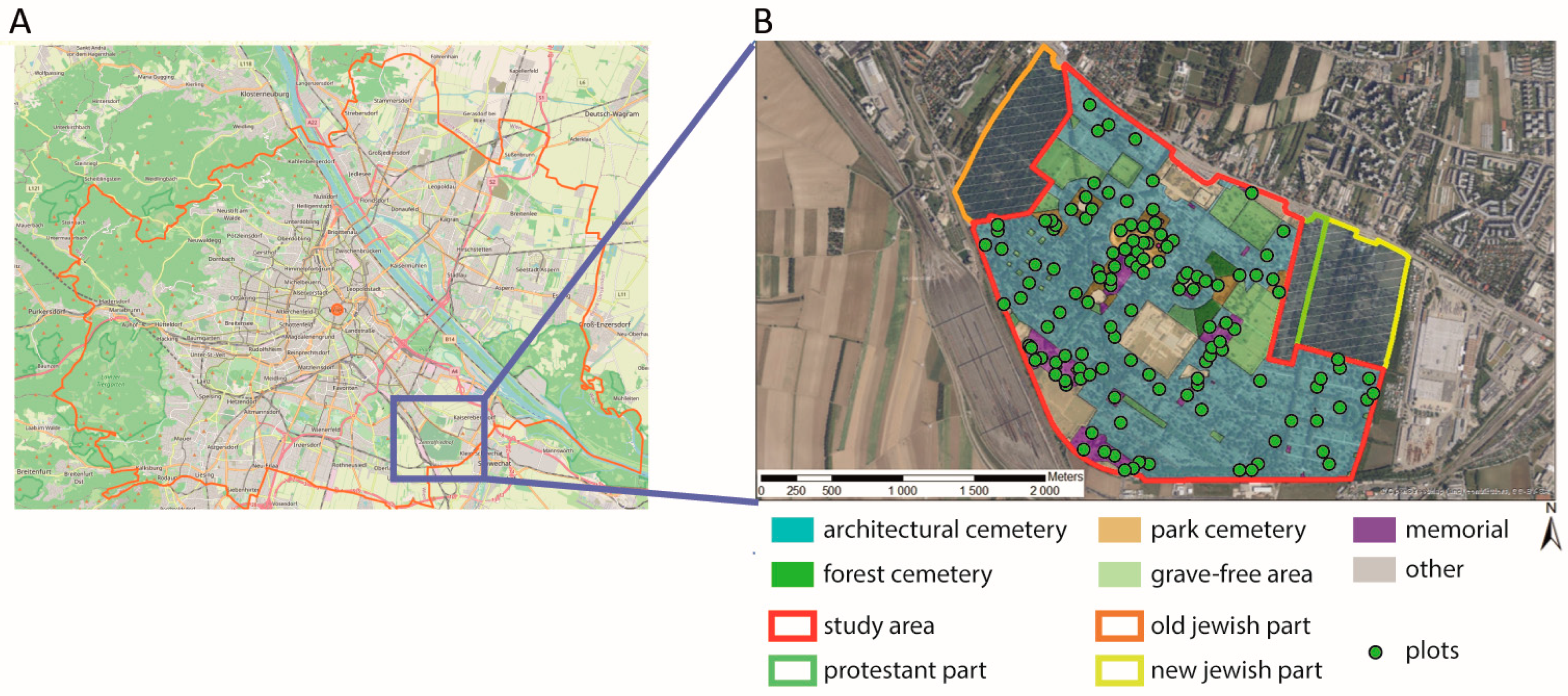
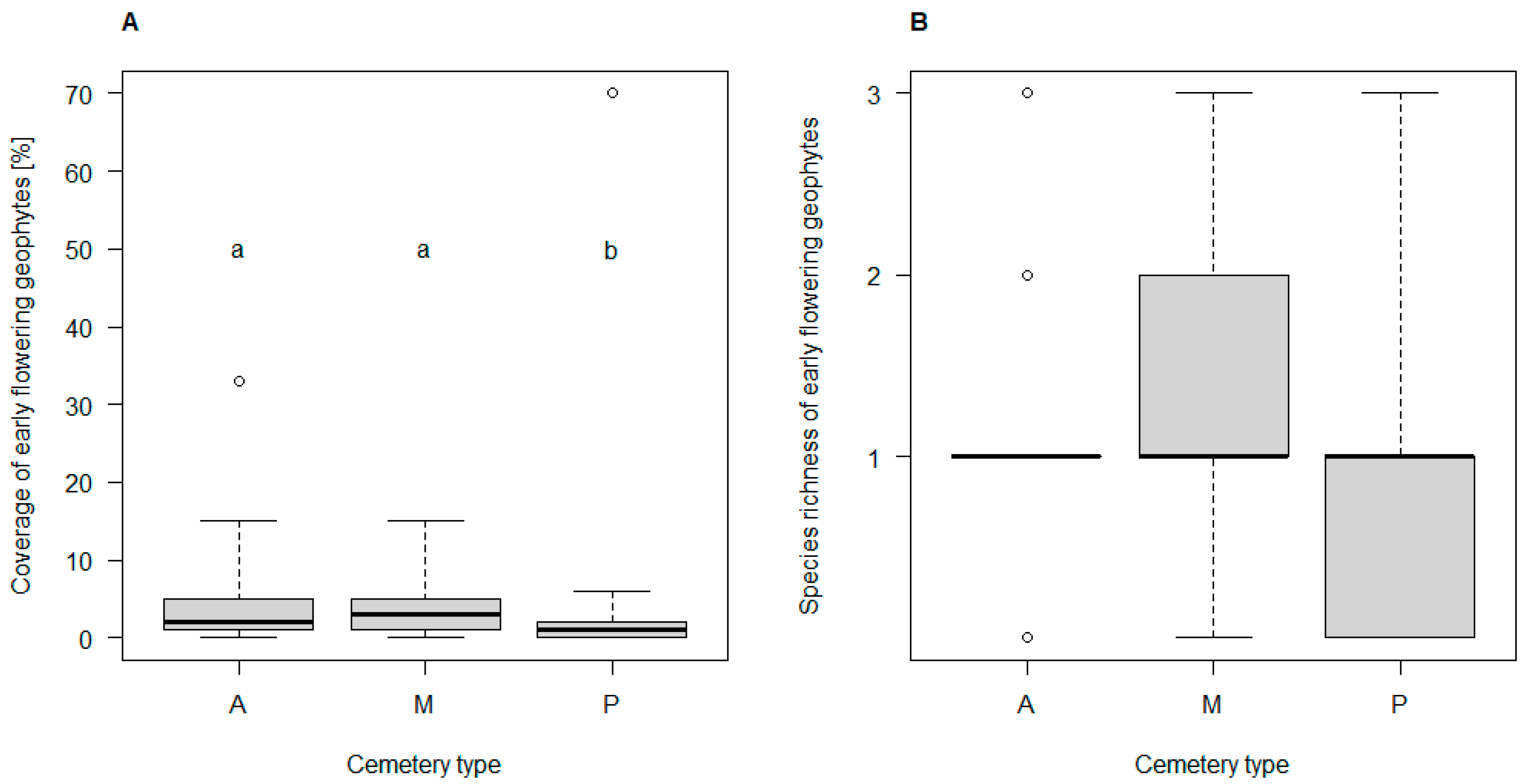
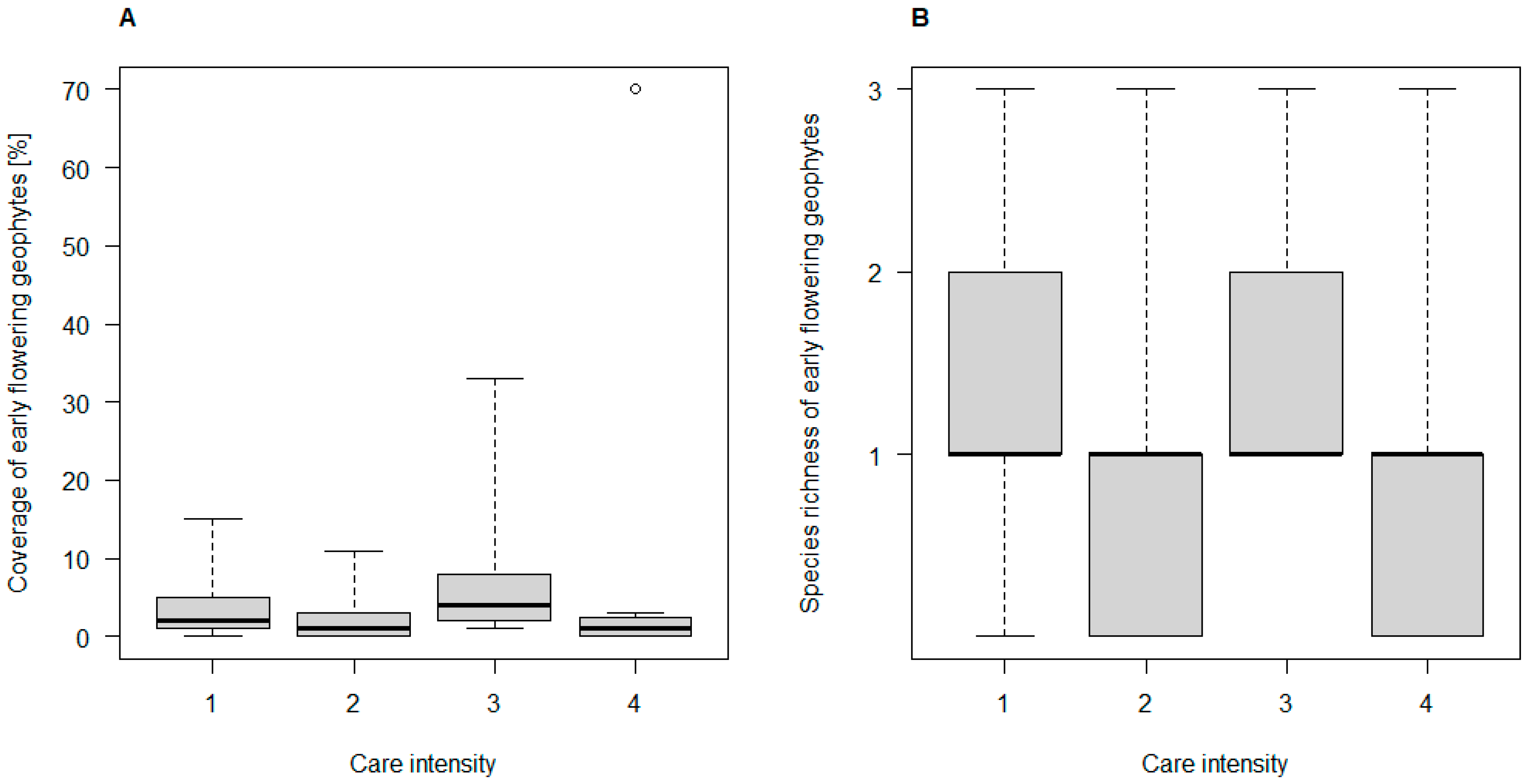


| Criteria | Definition |
|---|---|
| The grave makes a well-kept impression. | No dirt, no garbage, no broken elements, etc. |
| There are burning candles or other temporary elements at the grave. | Funeral wreaths, All Saints flower arrangements, Christmas or Easter decorations, etc. |
| There is intact decoration at the grave. | Fresh flowers, angels, lanterns, religious ornaments, etc. |
| A horticultural design can be seen. | Flowers, mowing of the green area of the grave, etc. |
| Category | Grave Maintenance | Definition |
|---|---|---|
| 1 | not to barely maintained | At most one of the assessment criteria has been fulfilled. |
| 2 | low to moderate maintained | Two of the assessment criteria have been fulfilled. |
| 3 | moderate to well maintained | Three of the assessment criteria have been fulfilled. |
| 4 | well to very well maintained | All of the assessment criteria have been fulfilled. |
| Category | Types of Use | Definition |
|---|---|---|
| 1 | Path between graves | An unsealed path with graves on the left and right. |
| 2 | Abandoned grave or pure lawn-grave | Abandoned graves: the gravestones and all other burial elements have been removed; Lawn-grave: there is only a simple gravestone on a meadow and no further delimitations of the grave. |
| 3 | Open space between street and graves | A green area that has to be crossed to get from the street to the graves. The graves border directly on the plot. |
| 4 | Open lawn with nearby graves | A free meadow area that is not directly adjacent to graves but located near them. |
| Species | Plot no. | Proportion | Status | Red Data List |
|---|---|---|---|---|
| Anemone nemorosa L. | 1 | 0.7 | I | nt |
| Eranthis hyemalis (L.) Salib. | 2 | 1.3 | op/nl | nt |
| Ficaria verna Huds. | 107 | 70.4 | I | nt |
| Gagea lutea (L.) Ker Gawl. | 3 | 2.0 | i+ | -r |
| Gagea pratensis (Pers.) Dumort. | 4 | 2.6 | i+ | 3 |
| Gagea cf. villosa (M.Bieb.) Sweet | 1 | 0.7 | le+ | -r |
| Galanthus nivalis L. | 6 | 3.9 | op/fp | -r |
| Muscari neglectum Guss. Ex Ten. | 1 | 0.7 | I | -r |
| Ornithogalum umbellatum agg * Parl. ** | 27 | 17.8 | I | 3r! |
| Total | 152 | 100 | - | - |
| A | ||||
| Estimate | Standard Error | t-Value | p-Value | |
| Intercept | 0.01 | 0.33 | 0.33 | 0.974 |
| Care intensity | −0.07 | 0.09 | −0.75 | 0.456 |
| Type of use | 0.05 | 0.08 | 0.62 | 0.534 |
| Distance to path | −0.00 | 0.01 | −0.22 | 0.828 |
| B | ||||
| Estimate | Standard Error | t-Value | p-Value | |
| Intercept | −4.15 | 0.39 | −10.61 | <0.001 |
| Care intensity | 0.08 | 0.08 | 0.95 | 0.340 |
| Type of use | 0.12 | 0.08 | 1.52 | 0.128 |
| Distance to path | 0.01 | 0.01 | 1.31 | 0.192 |
Publisher’s Note: MDPI stays neutral with regard to jurisdictional claims in published maps and institutional affiliations. |
© 2021 by the authors. Licensee MDPI, Basel, Switzerland. This article is an open access article distributed under the terms and conditions of the Creative Commons Attribution (CC BY) license (https://creativecommons.org/licenses/by/4.0/).
Share and Cite
Konic, J.; Essl, F.; Lenzner, B. To Care or Not to Care? Which Factors Influence the Distribution of Early-Flowering Geophytes at the Vienna Central Cemetery (Austria). Sustainability 2021, 13, 4657. https://doi.org/10.3390/su13094657
Konic J, Essl F, Lenzner B. To Care or Not to Care? Which Factors Influence the Distribution of Early-Flowering Geophytes at the Vienna Central Cemetery (Austria). Sustainability. 2021; 13(9):4657. https://doi.org/10.3390/su13094657
Chicago/Turabian StyleKonic, Julia, Franz Essl, and Bernd Lenzner. 2021. "To Care or Not to Care? Which Factors Influence the Distribution of Early-Flowering Geophytes at the Vienna Central Cemetery (Austria)" Sustainability 13, no. 9: 4657. https://doi.org/10.3390/su13094657
APA StyleKonic, J., Essl, F., & Lenzner, B. (2021). To Care or Not to Care? Which Factors Influence the Distribution of Early-Flowering Geophytes at the Vienna Central Cemetery (Austria). Sustainability, 13(9), 4657. https://doi.org/10.3390/su13094657






